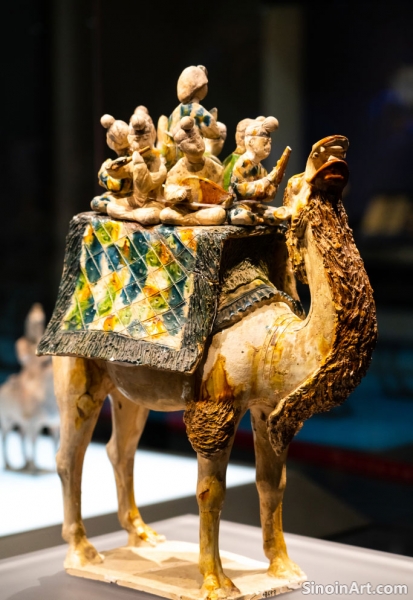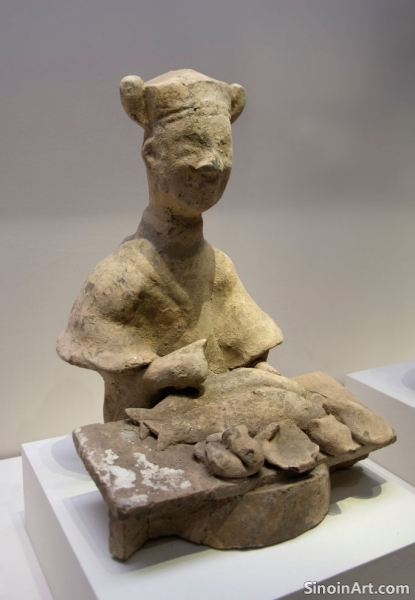The Decorative Motifs of Tang Ceramics
|
The decorative motifs found on Tang Dynasty ceramics are rich and varied, reflecting the diverse cultural influences and artistic trends of the era. These motifs, ranging from simple geometric patterns to complex figural depictions, not only enhance the aesthetic appeal of the wares but also provide insights into Tang beliefs, values, and artistic tastes.  Floral motifs were a common feature of Tang ceramics, particularly in celadon wares. Lotus flowers, peonies, and other stylized floral patterns were used to adorn bowls, dishes, and vases. These floral motifs not only added a touch of beauty and elegance but also symbolized prosperity, purity, and good fortune. The delicate rendering of floral designs demonstrates the high level of craftsmanship achieved by Tang potters.  Geometric patterns also featured prominently in Tang ceramic decoration. Simple bands, zigzags, and other abstract designs were often used to create borders or highlight specific areas of the ceramic piece. These patterns, while seemingly simple, demonstrated a sophisticated understanding of composition and balance. The use of geometric motifs added a touch of formality and structure to the decorative scheme.  Animal motifs were another significant category of Tang ceramic decoration. Depictions of horses, camels, dragons, and phoenixes were common, particularly in tomb wares. These motifs not only added visual interest but also held symbolic meaning. Horses represented power and status, while dragons and phoenixes symbolized good fortune and auspiciousness. Figural scenes, especially common in sancai wares, offer a window into Tang Dynasty life. Court ladies, musicians, dancers, and other figures were meticulously rendered, often wearing the clothing and hairstyles of the time. These figural scenes provide valuable insights into the social customs and daily life of the Tang Dynasty. |
Tag : Tang Dynasty ceramic motifs, Chinese pottery decoration, ancient floral patterns, animal motifs in ceramics, figural pottery designs
Related information
- The Evolution of Tang Porcelain Forms
- The Economic Importance of Tang Ceramic Production
- Technological Advances in Tang Kilns
- Tang Ceramics and Foreign Trade
- The Dawn of Celadon Splendor
The forms and shapes of Tang Dynasty ceramics were as diverse and dynamic as the society that produced them. From simple utilitarian bowls to elaborate ceremonial vessels, the ceramic forms reflected the varied functions and aesthetic preferences of the time. The evolution of Tang ceramic forms was also driven by technical innovations and artistic experimentation, resulting in a wide range of shapes and sizes that showcase the ingenuity of Tang potters.
Tang Dynasty ceramic production was economically significant, providing employment, fostering trade both domestically and internationally, and contributing significantly to the empire’s wealth, thereby stimulating economic growth.
Tang Dynasty advancements in kiln technology, such as high-firing kilns and lead glaze control, enabled potters to produce a greater variety of higher-quality ceramics, significantly influencing later ceramic traditions.
The Tang Dynasty's open trade policies and the prominence of the Silk Road facilitated the widespread distribution of Tang ceramics to foreign lands. These ceramic wares, renowned for their beauty and quality, became valuable commodities in international trade, bringing Tang artistry and craftsmanship to distant corners of the world. The impact of this trade was significant, not only economically but also culturally.
The Tang Dynasty (618-907 AD) represents a crucial period in the history of Chinese ceramics, particularly in the development and refinement of celadon wares. While not as dramatically innovative as the later Song dynasty, the Tang era saw a significant leap in kiln technology, material preparation, and artistic understanding that laid the groundwork for future ceramic masterpieces. Celadon, with its subtle green hues reminiscent of jade, enjoyed immense popularity, favored by both the imperial court and the burgeoning merchant class. Tang celadon wasn't just about mimicking jade; it was about capturing the essence of natural beauty and the philosophical ideals of the time.